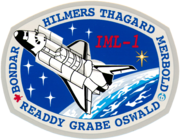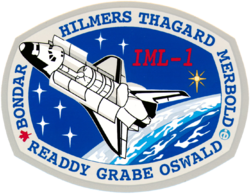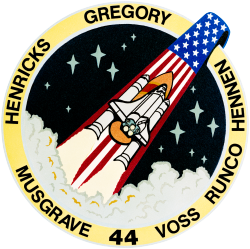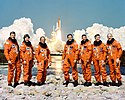STS-42
| STS-42 | |||||
 | |||||
| Uppdrag | 45 | ||||
|---|---|---|---|---|---|
| Rymdfärja | Discovery (14)[1] | ||||
| NSSDC-ID | 1992-002A[2] | ||||
| Färdens tid | 8 dagar, 1 timmar, 14 minuter, 44 sekunder | ||||
| Uppskjutning | |||||
| Startplats | Startplatta 39A vid Kennedy Space Center i Florida | ||||
| Start | 22 januari 1992 14:52:33 UTC | ||||
| Landning | |||||
| Landningsplats | Edwards Air Force Base | ||||
| Landning | 30 januari 1992 16:07:17 UTC | ||||
| Omloppsbana | |||||
| Varv | 128 st[3] | ||||
| Apogeum | 307 km | ||||
| Perigeum | 291 km | ||||
| Banlutning | 57,0° | ||||
| Sträcka | 4,701 miljoner km | ||||
| Besättning | |||||
| Befälhavare | Ronald J. Grabe (3) | ||||
| Pilot | Stephen S. Oswald (1) | ||||
| Uppdragsspecialister | Norman Thagard (4) David C. Hilmers (4) William F. Readdy (1) | ||||
| Nyttolastspecialister | Roberta Bondar (1) Kanada Ulf Merbold (2) Tyskland | ||||
 | |||||
| Kronologi Rymdfärjeprogrammet | |||||
| |||||
STS-42 var den fyrtiofemte flygningen i det amerikanska rymdfärjeprogrammet, den fjortonde flygningen med rymdfärjan Discovery. Den sköts upp från Pad 39A vid Kennedy Space Center i Florida den 22 januari 1992. Efter drygt åtta dagar i omloppsbana runt jorden återinträdde rymdfärjan i jordens atmosfär och landade vid Edwards Air Force Base i Kalifornien.
Se även
Referenser
- ^ NASA Space Shuttle Launch Archive Arkiverad 19 september 2012 hämtat från the Wayback Machine., läst 28 juli 2016.
- ^ ”NASA Space Science Data Coordinated Archive” (på engelska). NASA. https://nssdc.gsfc.nasa.gov/nmc/spacecraft/display.action?id=1992-002A. Läst 19 mars 2020.
- ^ Manned Astronautics - Figures & Facts Arkiverad 16 augusti 2016 hämtat från the Wayback Machine., läst 28 juli 2016.
Externa länkar
 Wikimedia Commons har media som rör STS-42.
Wikimedia Commons har media som rör STS-42.
| ||||||||
| ||||||||||||||||||||||||||||||||
Media som används på denna webbplats
Författare/Upphovsman: Pascal (Flickr user: pasukaru76), Licens: CC0
Vostok spacecraft replica at the Technik Museum Speyer, Germany.
STS-45 Mission Insignia
STS-42 Mission Insignia
STS-44 Mission Insignia
The STS-42 crew portrait includes from left to right: Stephen S. Oswald, pilot; Roberta L. Bondar, payload specialist 1; Norman E. Thagard, mission specialist 1; Ronald J. Grabe, commander; David C. Hilmers, mission specialist 2; Ulf D. Merbold, payload specialist 2 and William F. Readdy, mission specialist 3. Launched aboard the Space Shuttle Discovery on January 22, 1992 at 9:52:33 am (EST), the STS-41 served as the International Microgravity Laboratory-1 (ML-1 ) mission.








